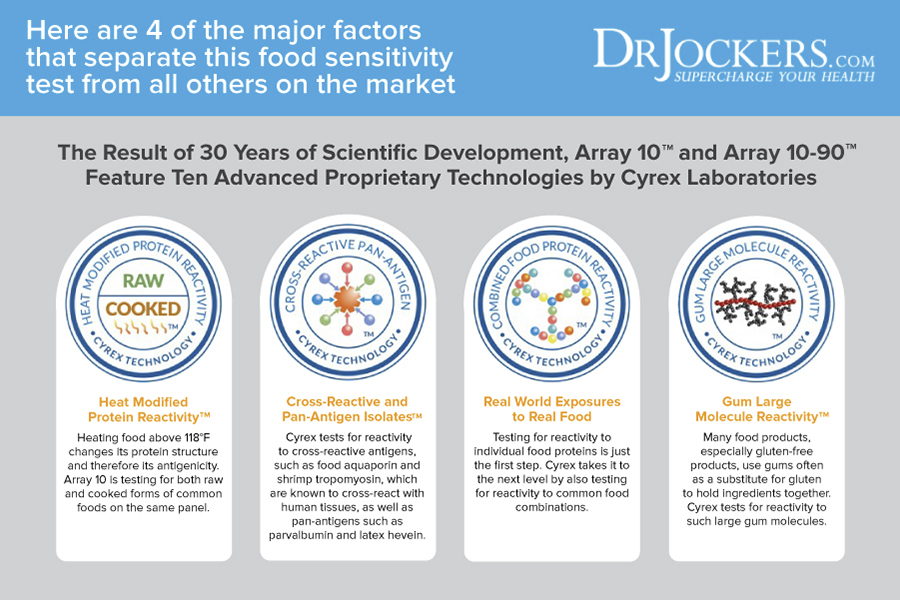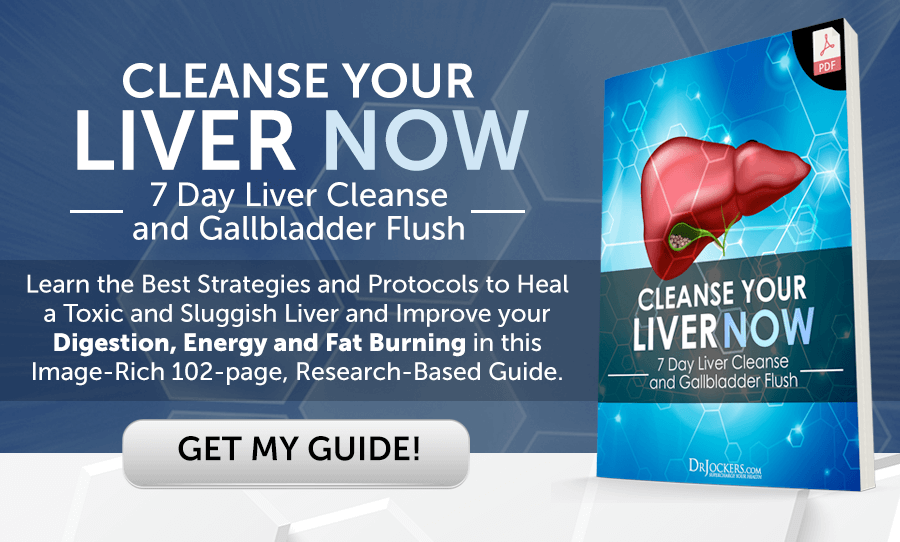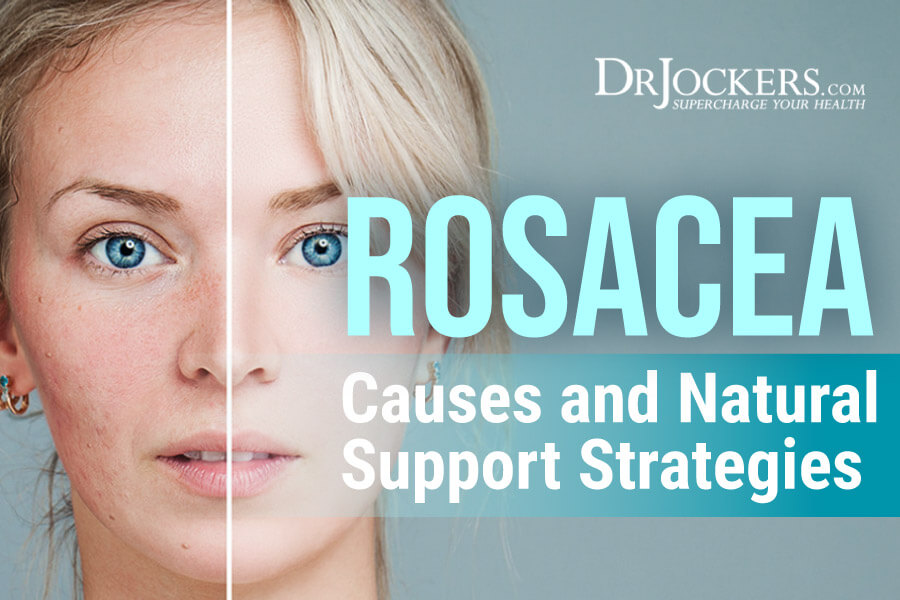 Rosacea: Causes and Natural Support Strategies
Rosacea: Causes and Natural Support Strategies
Rosacea is a common inflammatory skin condition characterized by facial redness, visible blood vessels, and other visible symptoms on your skin. It affects 16 million Americans. If you have rosacea, you know that it can be an uncomfortable and sometimes embarrassing skin condition. The good news is that once you identify its root causes, you may be able to see noticeable improvement.
In this article, you will learn what is rosacea, its symptoms, and its major causes. You will learn what are the best tests to identify the root causes of your rosacea. I will also share with you some powerful natural support strategies to improve your digestive, skin and immune health.

What Is Rosacea
Rosacea (roe-ZAY-she-uh) is a common, visible, inflammatory skin condition that affects about 16 million Americans and around 415 million people around the world. It results in facial redness and visible blood vessels (1, 2).
At first, rosacea may be apparent by a tendency of blushing or flushing more easily than others. It may also result in small, red, pus-filled bumps mainly on your cheeks, nose, chin, and forehead. In some cases, it may spread to the ears, chest, or back as well.
Rosacea has several subtypes that are characterized by different symptoms, including (3, 4):
- Subtype 1: Erythematotelangiectatic rosacea is characterized by redness, flushing, and visible blood vessels.
- Subtype 2: Papulopustular rosacea is characterized by redness, swelling, and breakout similar to acne.
- Subtype 3: Phymatous rosacea is characterized by thickened skin with bumps.
- Subtype 4: Ocular rosacea is characterized by red and irritated eyes and swollen eyelids.
Rosacea may develop for a variety of reasons, however, it seems that genetics may be a contributing factor. According to research at Stanford University School of Medicine, using the tools of the genetics company 23andme, rosacea seems to have a genetic basis. The prevalence of rosacea is greater in Northern European countries and among those with Northern European (eg. Celtic or Scandinavian) ancestry and genes. It is also more common and visible in fair-skinned people. These findings may help researchers to understand the condition better to find effective treatment and prevention strategies (5).
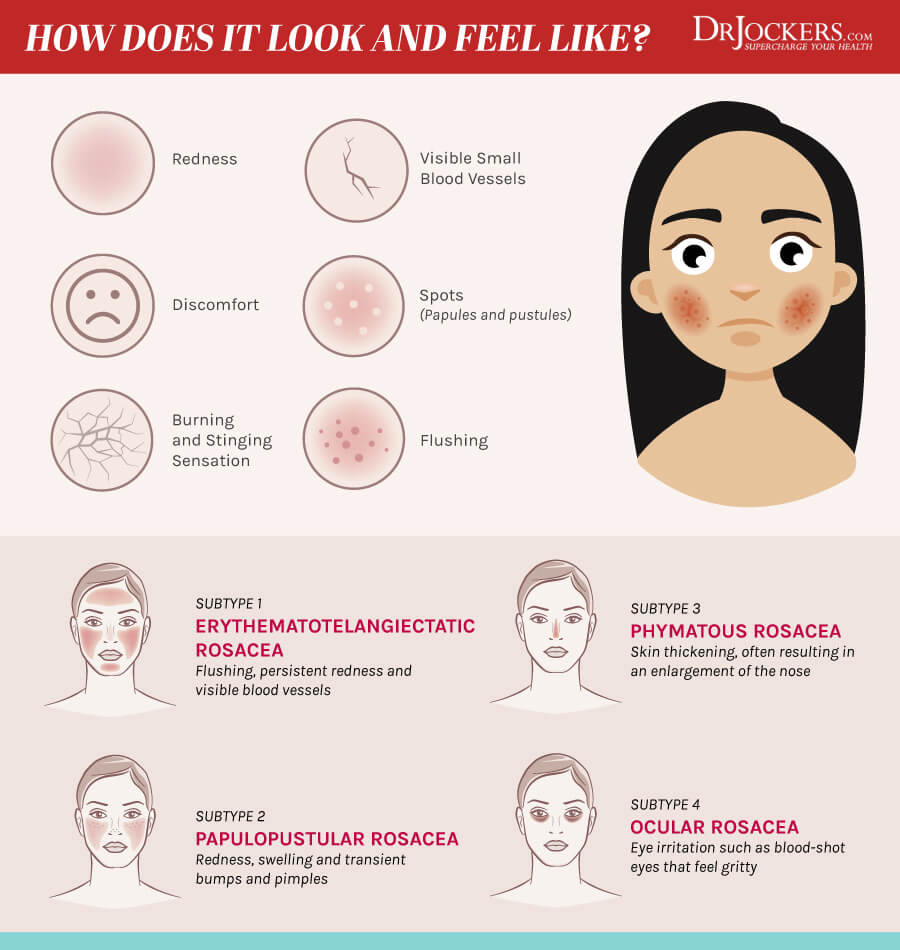
Symptoms Associated with Rosacea
Signs and symptoms of rosacea usually come in flares. They may flare up for a few weeks or even a few months. Then you may be symptom-free for a few days, weeks, or months until your next flare. Since some symptoms may be similar, rosacea may be confused with acne, allergic reactions, and other skin problems at first.
Let’s look at the symptoms associated with rosacea for each subtype (6, 7, 8).
Signs and Symptoms of Rosacea Subtype 1
- Redness and flushing in the center of the face
- Visibly broken blood vessels (spider veins)
- Facial swelling
- Sensitive skin
- Dry, rough, or scaling skin
- A tendency to blush or flush easily
Signs and Symptoms of Rosacea Subtype 2
- Acne-like breakouts in red skin areas
- Oily skin
- Sensitive skin
- Visibly broken blood vessels
- Burning or stinging skin (spider veins)
- Plaques (visible raised skin patches)
Signs and Symptoms of Rosacea Subtype 3
- Bumpy skin
- Thickening of the skin, especially on the nose, called rhinophyma (rye-NO-fie-ma)
- Thickening of the skin on the chin, cheeks, forehead, and ears
- Oily skin
- Large pores
- Visibly broken blood vessels (spider veins)
Signs and Symptoms of Rosacea Subtype 4
- Watery or bloodshot eyes
- Gritty feeling in the eyes that feels like sand
- Burning or stinging in the eyes
- Very dry eyes
- Itchy eyes
- Blurry vision
- Sensitivity to lights
- Visibly broken blood vessels (spider veins) on an eyelid
- Cyst of the eyelid
- Not seeing as well as before
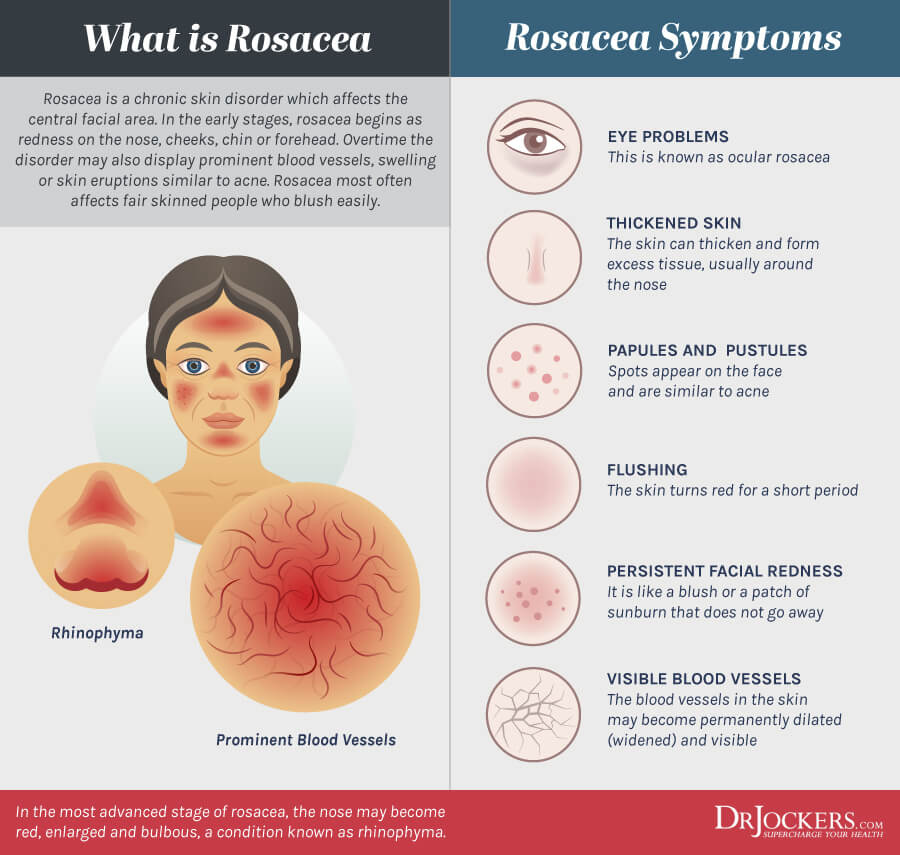
Major Causes of Rosacea
As you’ve learned, genetics, such as a Northern European ancestry or being fair-skinned may increase your risk of rosacea. If you have someone with rosacea in your family, you are more likely to develop it as well. Rosacea is more likely to develop in those between 30 and 50, though it may affect all ages.
There are a variety of things that may trigger rosacea flares, including hot drinks, spicy foods, alcohol, cosmetics, drugs that dilate your blood vessels, sunlight, wind, temperature extremes, emotions, and exercise. However, there are some important factors besides genetics that may be the underlying cause of rosacea. Let’s look at the five major causes of rosacea.
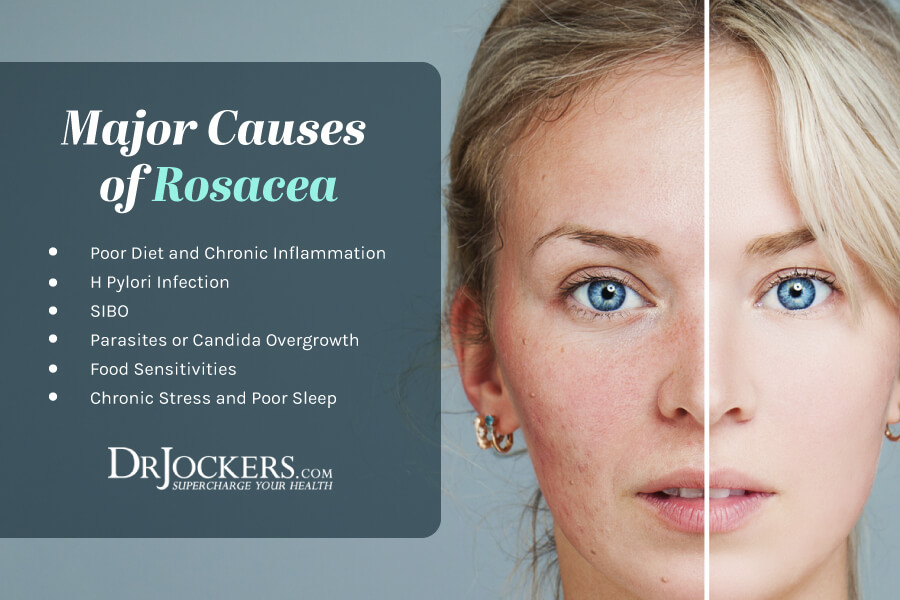
Poor Diet and Chronic Inflammation
The immune system may play an incredibly important role in rosacea. Gut inflammation may be one of the underlying causes of a compromised immune system. Research has found an association between inflammatory gastrointestinal tract disorders and rosacea, as well as other skin problems, including psoriasis, acne, and dermatitis (9).
Hence, it’s very important that you keep your inflammation levels at bay. A poor diet high in refined sugar, refined oils, and processed foods, and low in organic greens, vegetables, fruits, healthy fats, and clean protein, is one of the major causes of chronic inflammation, which is the main underlying cause of chronic diseases, including rosacea.

H Pylori Infection
Helicobacter pylori (H. pylori) is a gram-negative bacillus that is one of the main underlying causes of chronic gastritis, gastrointestinal ulcers, and gastric cancer. It may also play a role in the development of other health conditions, including rosacea.
According to a systemic search of 17 articles on the correlation between H. pylori and rosacea, it seems that the infection plays a role in rosacea. Research suggests that those with rosacea should be tested for H. pylori infections. In case they have the infections, treating H. pylori may also help to clear up their rosacea as well (10).
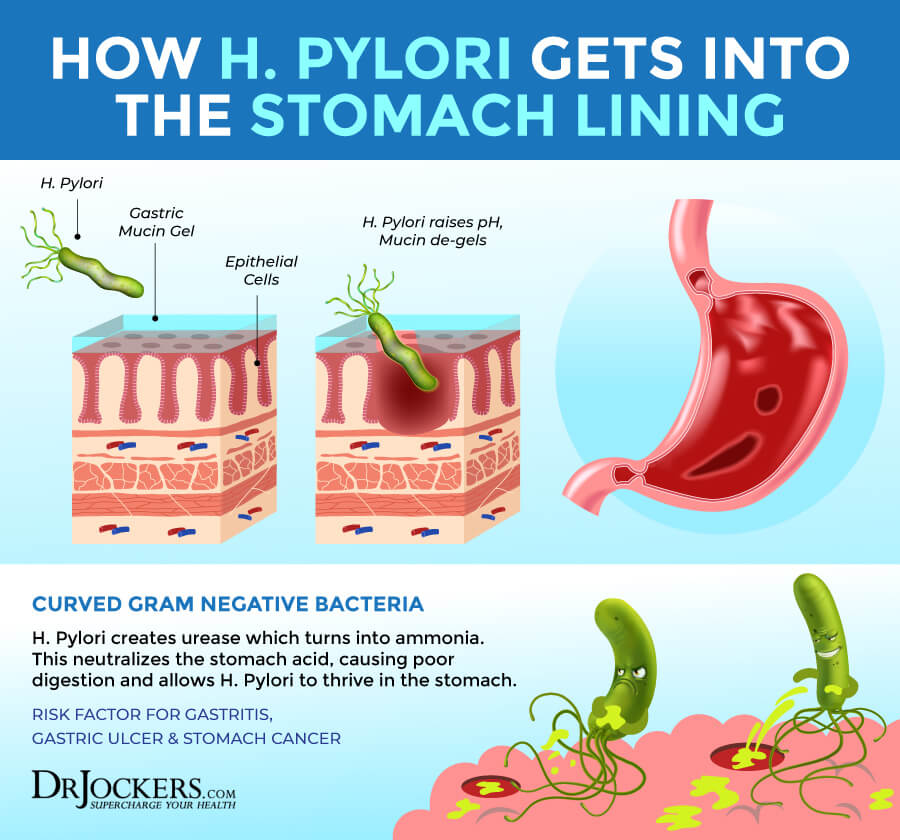
SIBO
Small intestinal bacterial overgrowth (SIBO) happens when someone has an unusually large population of bacteria in their small intestine that under normal circumstances should not be there. SIBO may be one of the root causes or complications of other gut health problems, such as irritable bowel syndrome (IBS), celiac disease, and Crohn’s disease. It may also lead to further inflammation in the body and other health issues, including rosacea and autoimmune conditions (11).
A 2008 research compared 113 participants with rosacea and 60 participants without rosacea to better understand the role of SIBO in the development and treatment of rosacea. All participants were tested for SIBO with lactulose and glucose breath tests (BTs). Researchers found that the presence of SIBO was greater in the rosacea group than in the control group.
Eradication of SIBO has led to the improvement or complete resolution of rosacea in most cases and participants maintained great results for 9 months or longer after the treatment. These results suggest that testing for SIBO may be important for finding and treating the root causes of rosacea (12).
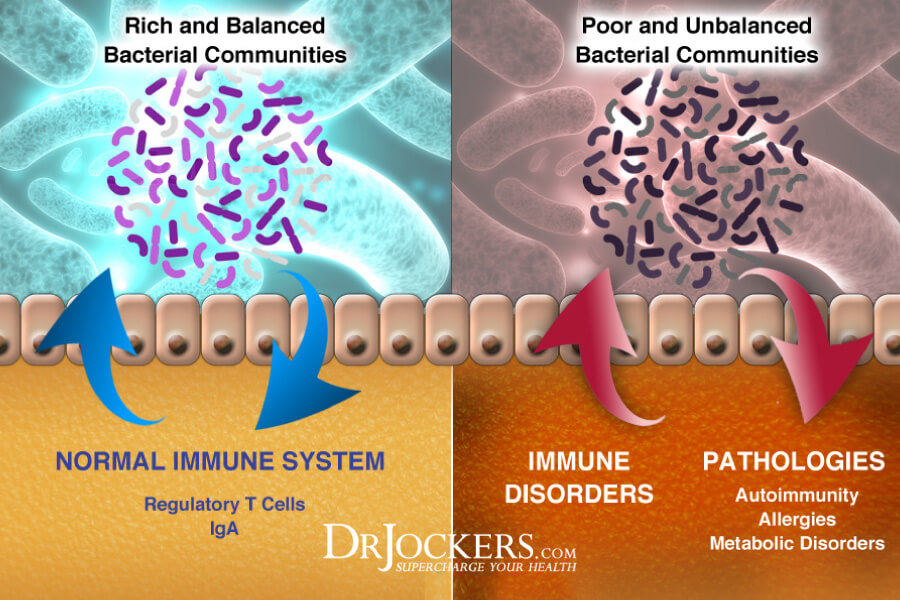
Food Sensitivities
Food sensitivities may increase your risk of inflammation, immune system issues, and skin conditions, including rosacea. Certain foods may also trigger rosacea flare-ups.
Identifying your triggers and food sensitivities, and eliminating them from your diet may reduce or eradicate your rosacea symptoms. Common food sensitivities and triggers may include gluten, sugar, hot drinks, alcohol, spicy foods, histamine-increasing foods, and cinnamaldehyde-containing foods which include tomatoes, chocolate, citrus, and cinnamon (14).
In one survey by the National Rosacea Society of over 400 patients, 78% had altered their diet due to rosacea. Of this group, 95% reported a subsequent reduction in flares (13). This group reported several triggers related to heat, alcohol, capsaicin, and cinnamaldehyde containing foods. For the heat category, hot coffee aggravated 33% of rosacea cases and hot tea triggered 30%. For alcohol, the respondents reported that wine (52%) and hard liquor (42%) were common triggers.
Capsaicin is a compound found in peppers and certain spices. 75% of the survey respondents found this to be a trigger with hot sauce (54%), cayenne pepper (47%) and red pepper (37%). The cinnamaldehyde group of founds are seemingly unrelated but they contain clinically significant amounts of the cinnamaldehyde compound. In this survey, they ranked as follows tomatoes triggered 30%, chocolate aggravated 23%, citrus at 22%, and cinnamon at 20%.
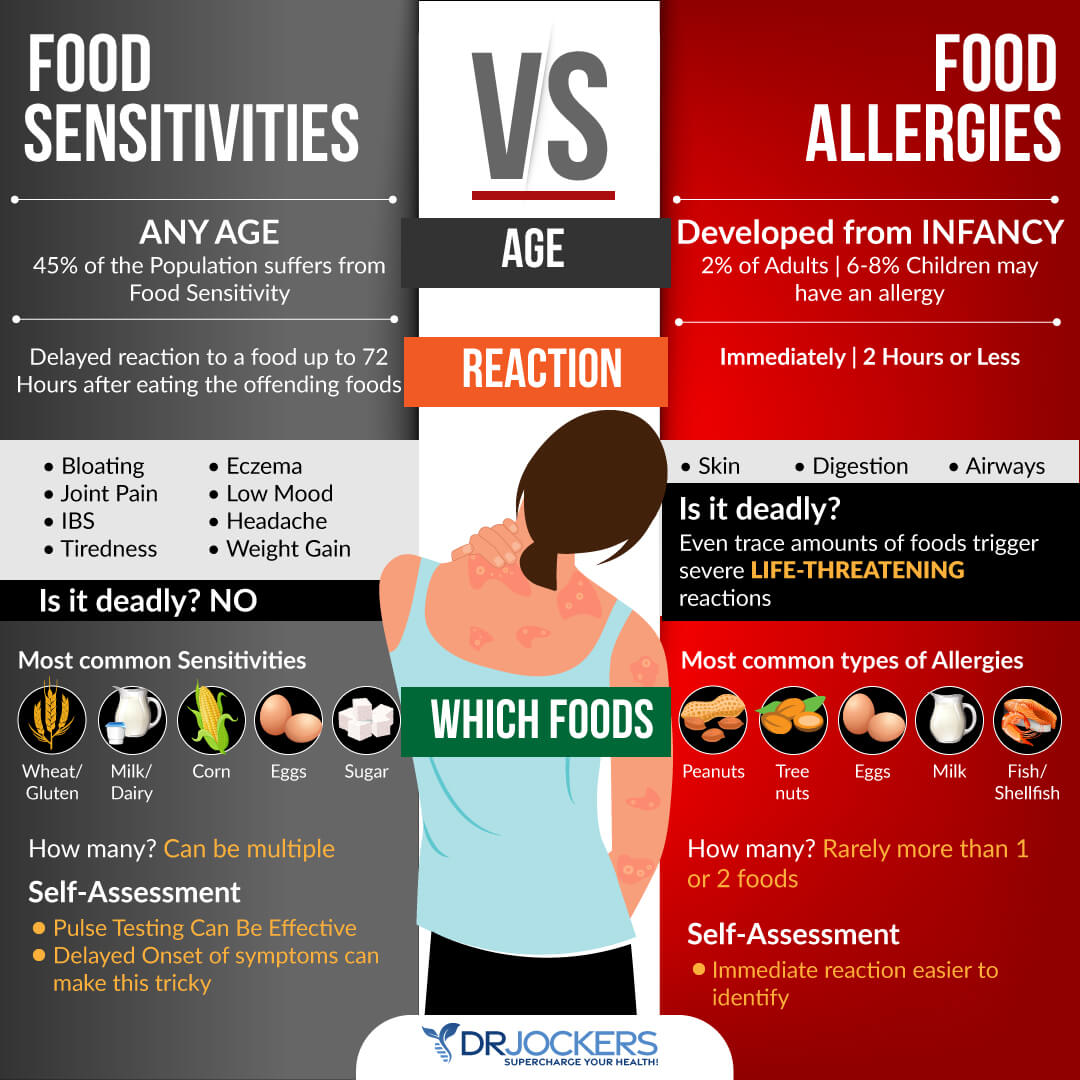
Chronic Stress and Poor Sleep
A variety of issues may lead to rosacea, a chronic and complex skin condition. Chronic stress is certainly one of them.
Chronic stress and poor sleep may both lead to increased inflammation and a compromised immune system that may lead to an array of health conditions, including rosacea and other skin issues. Stress and anxiety may also trigger or worsen the symptoms of rosacea, whereas stress management techniques, such as breathing exercises and plenty of rest may help with its symptoms (15).
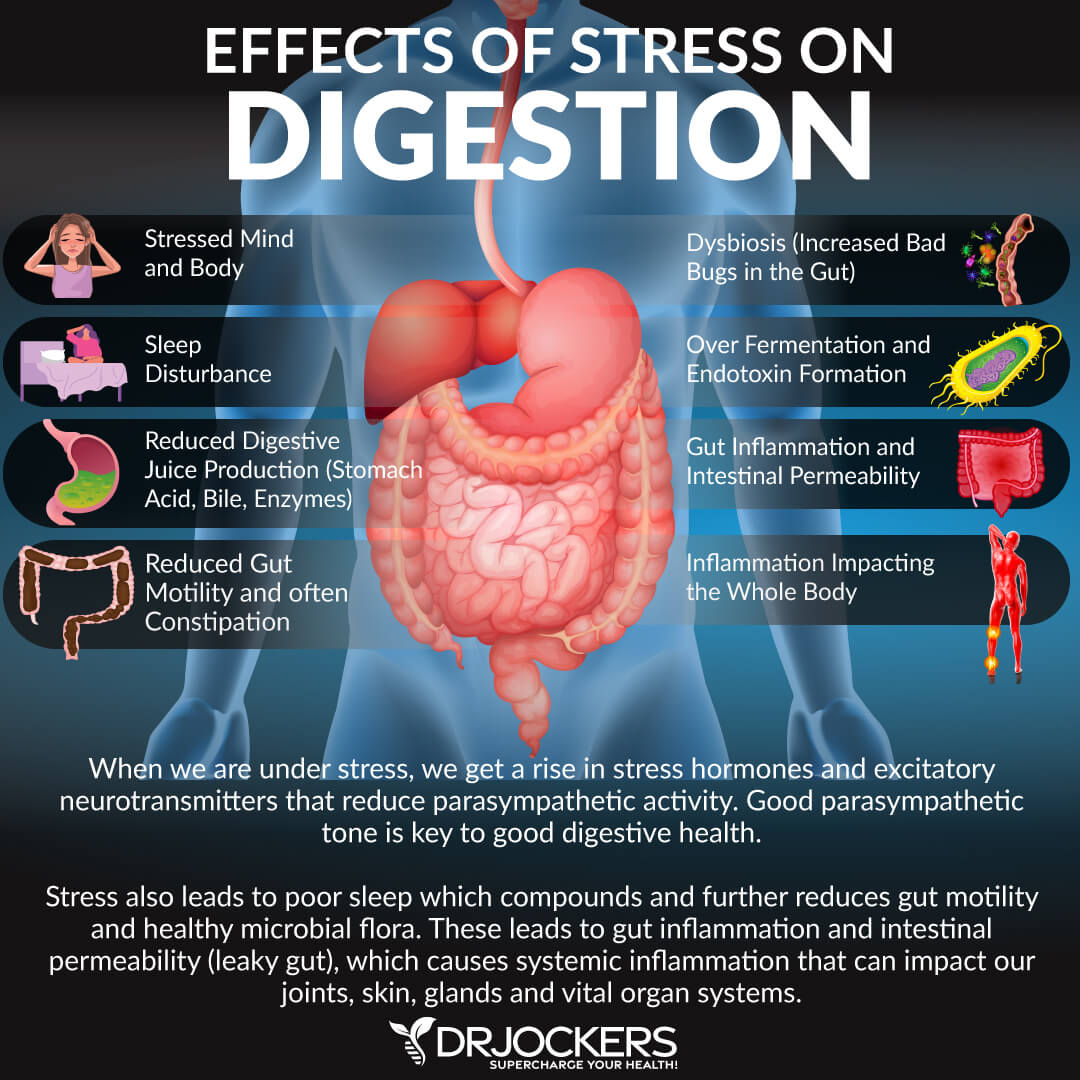
Best Tests for Individuals Struggling with Rosacea
There are a variety of tests I recommend for those who are struggling with rosacea, including a GI MAP Stool Test, a SIBO Breath Test, and food sensitivity testing.
GI MAP Stool Test
Your gut plays a role in over 80 percent of your immune system. Poor bacterial balance or dysbiosis, bacteria, and parasite overgrowth have been associated with digestive tract disorders, autoimmune conditions, brain and mental health issues, and skin issues, such as rosacea. This is why I recommend a GI MAP Stool Test that tests for H Pylori, parasites, and dysbiosis.
This test is the most thorough stool test I’ve found that gives actionable biomarkers that help any natural health doctor to figure out the root cause of your rosacea and other potential health issues and prescribe the right protocol to regain your health.
SIBO Breath Test
As you already know, SIBO may be one of the underlying causes of your rosacea or other health issues. This is why I recommend the SIBO Breath Test.
This is a non-invasive breath collection that involves a lactulose challenge to detect bacterial overgrowth in the distal small intestine and to reveal SIBO in patients with slow transit times. Make sure to follow the instruction package to perform this simple at-home test to check for potential SIBO.
Food Sensitivity Testing
Food sensitivities are one of the most common causes of skin conditions, such as rosacea, inflammation, unexplained chronic symptoms, and a variety of chronic diseases. This is why I always encourage my patients and readers to look for food sensitivities.
Going on an elimination diet and performing some muscle response testing or pulse testing are several ways you may test for food sensitivities at home by yourself. You may also get a blood test, such as a Mediator Release Test (MRT), an Antigen Leukocyte Cellular Antibody Test (ALCAT), an Immunoglobulin or Antibody Test for IgG, IgA, and IgM antibodies, an Enzyme-Linked Immunosorbent Assay (ELISA) Test, a Food Test 95, a Dietary Antigen and Environmental Allergen Exposure Profile for IgE, IgG, and IgG4, or a Cyrex Array 10-90X Test.
Out of all these options, I regularly recommend the Cyrex Array 10-90X as the most thorough and accurate means of testing for food sensitivities. It is a dual-antibody test that evaluates both IgG and IgA antibodies analyzing 180 cooked, raw, and modified food reducing the possibility of missing reactivities or missed results.
You may read about these food sensitivity testing options and why Cyrex Array 10-90X may be your best option in this article. Along with any testing, I always recommend watching your body’s reactions to possible sensitivities.
Natural Support Strategies
Reducing or even completely eliminating your rosacea symptoms is possible through natural means. Rosacea is strongly associated with disruption in the microbiome and gut inflammation. There are natural support strategies that can help improve your skin and immune health.
Your plan to improve your health should follow a 3-step method of support strategies to make key lifestyle changes, remove digestive challenges, and restore your microbiome.
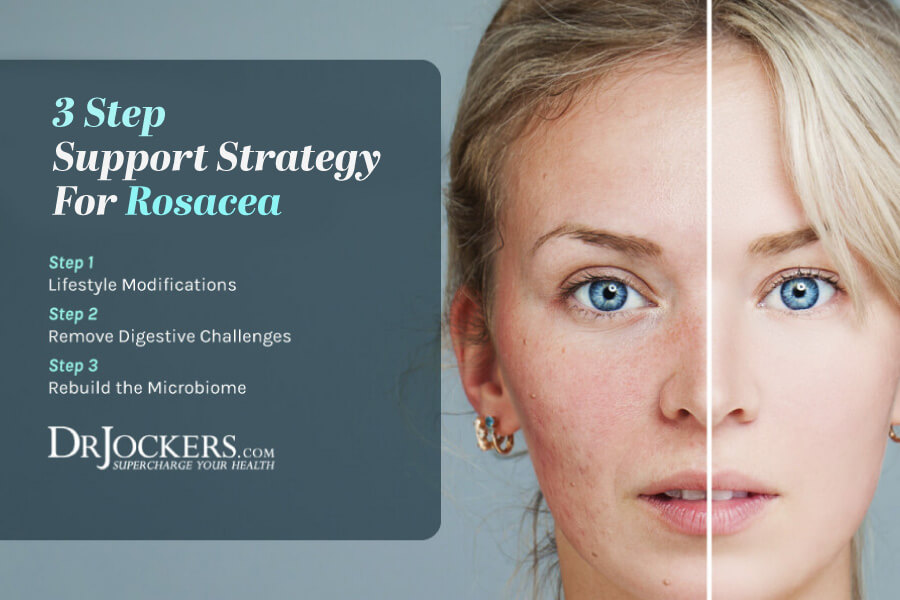
Step 1 – Lifestyle
To overcome rosacea, it is important that you create a healthy foundation for your body to repair through a healthy lifestyle. An anti-inflammatory diet, low stress, good sleep, and good hydration are all important practices for health improvement.
The following strategies are not FDA-approved to prevent, mitigate, treat, or cure rosacea but they can be extremely helpful for your body and overall wellness.
Anti-Inflammatory Diet
Eating an anti-inflammatory diet is key to repairing your body and creating overall health. It is a non-negotiable for reducing rosacea as well. Eliminate refined sugars, refined oils, unhealthy fats, processed foods, junk foods, artificial ingredients, and toxins from your diet.
Focus on nutrient-dense, anti-inflammatory foods, including leafy greens, such as kale, spinach, and collard greens, non-starchy vegetables, such as cucumber and celery, herbs and spices, such as turmeric, ginger, rosemary, and basil, low-glycemic index fruits, such as berries and lemon, healthy fats, such as avocados, organic ghee and butter, and coconut oil, clean protein, such as organic grass-fed beef, pasture-raised poultry, wild-caught fish, wild game, and free-range eggs, nuts and seeds for fiber, and fermented foods, such as kimchi, sauerkraut, and kefir for gut health. For more information on an anti-inflammatory diet, read this article.
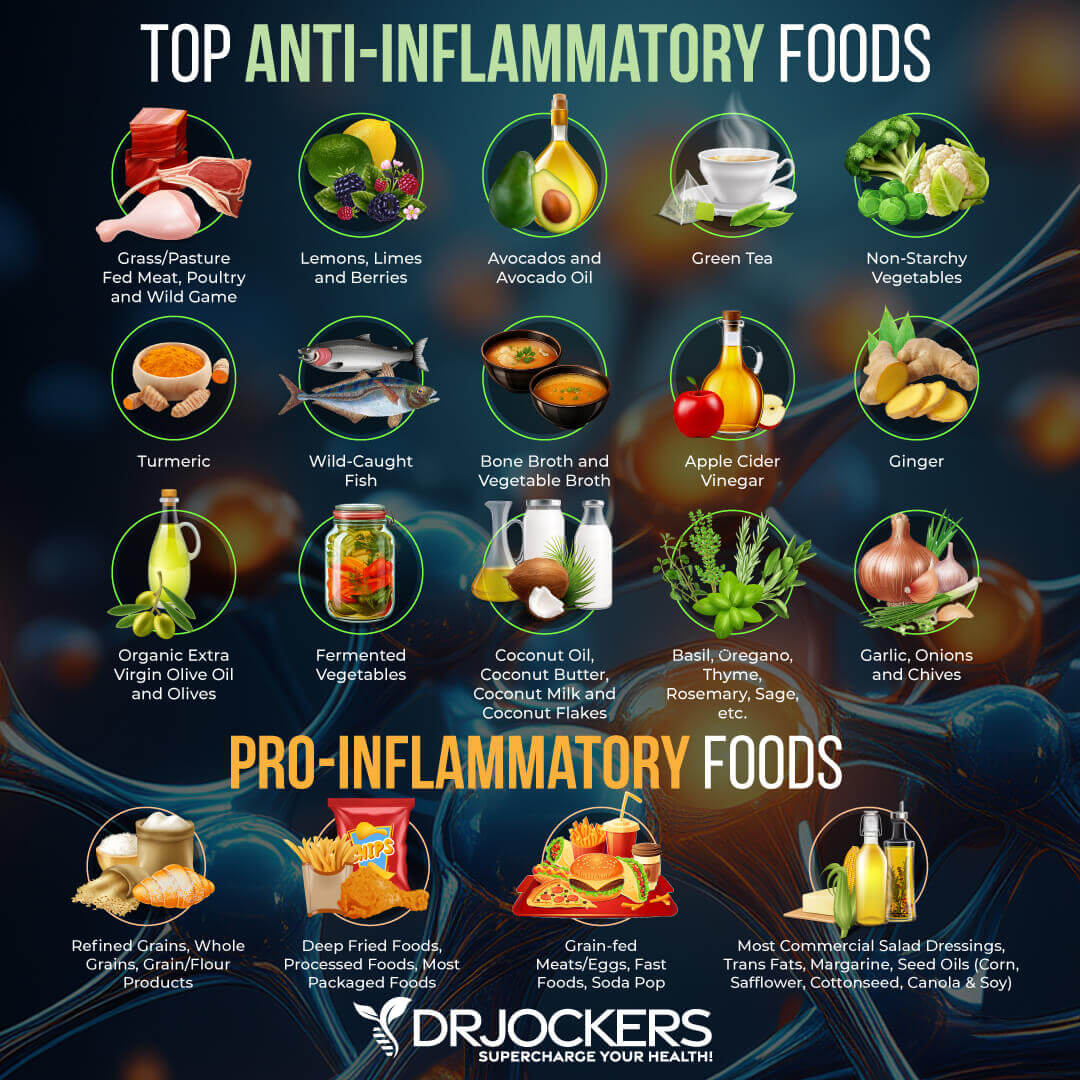
Reduce Stress
Chronic stress and high stress may be one of the main triggers for rosacea. So it’s important to take measures to reduce your stress levels to reduce your current symptoms and prevent future flare-ups.
Meditation, breathing exercises, journaling, daily gratitude, prayer, regular exercise, nature walks, ‘me-time’, and quality time with loved ones are fantastic ways to reduce your stress levels. Positive self-talk and mindset shifts may also help you deal with stressful situations, reframing your thoughts, and reducing anxiety.
Most people are short shallow breathers and this induces the fight or flight part of our nervous system. Taking time to take long, deep breaths will help put your body back into a state of healing and repair.
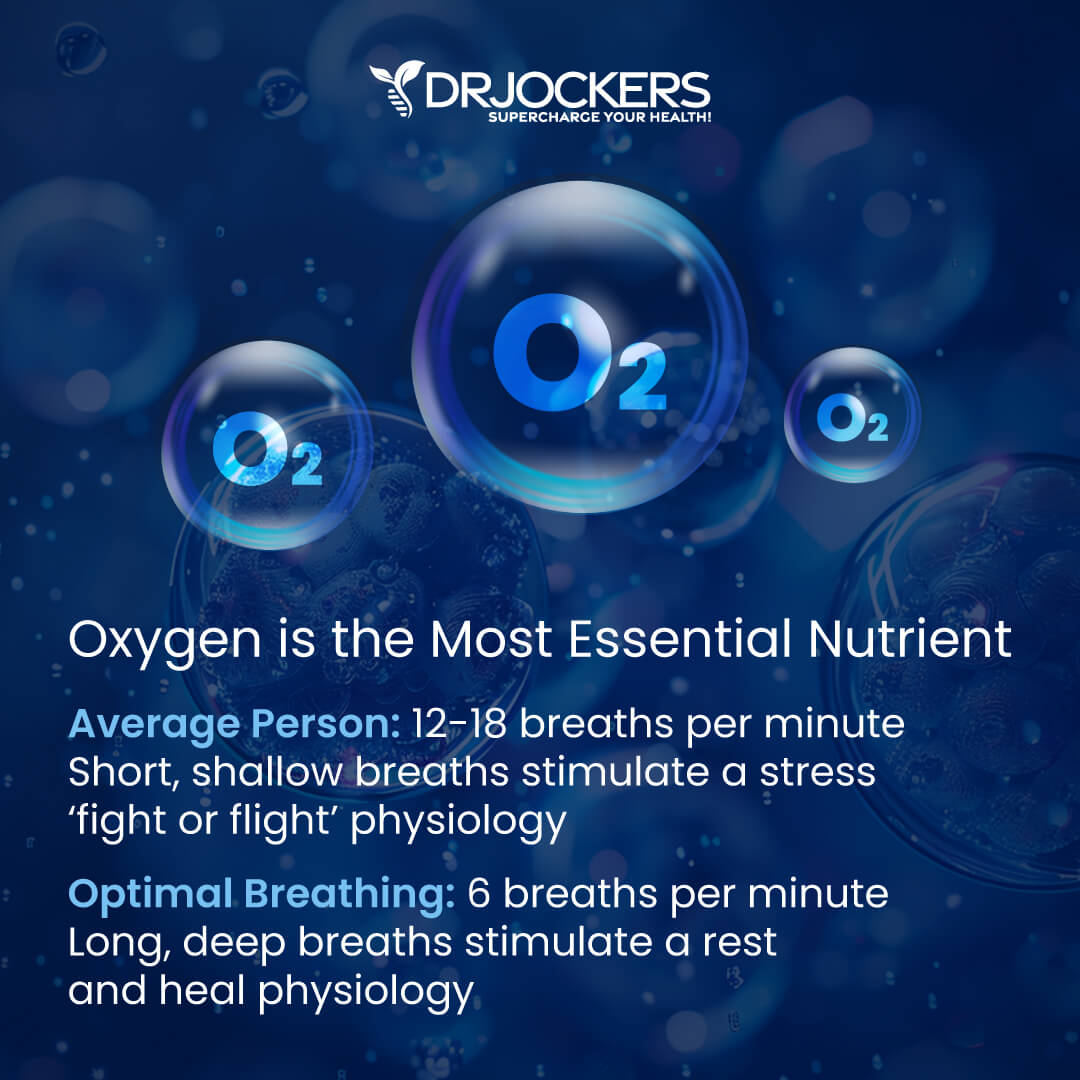
Improve Sleep Quality
Your body needs quality sleep and rest to repair. Make sure that you develop a regular sleep schedule.
Try to go to bed every night and wake up every morning at the same time to support your circadian rhythms. Make sure that you have a supportive bed with comfortable pillows and bedding. Develop a bedtime routine that works for you. Avoid caffeine and sugar, especially in the afternoon or evening. Turn off electronics close to bedtime. Engage in relaxational activities and perhaps sip on a calming herbal tea before bed.

Good Hydration
Most of your body is made up of water. Hence good hydration is essential for your overall health. It is important for detoxification, low inflammation levels, and energy.
Make sure to drink 8 to 10 glasses of purified water a day. More if you exercise a lot, do physical work, spend a lot of time in the hot sun, feel sick, or simply thirsty. On top of your water intake, support your hydration with hydrating vegetables and fruits, green juices, green smoothies, healing soups, and herbal tea.
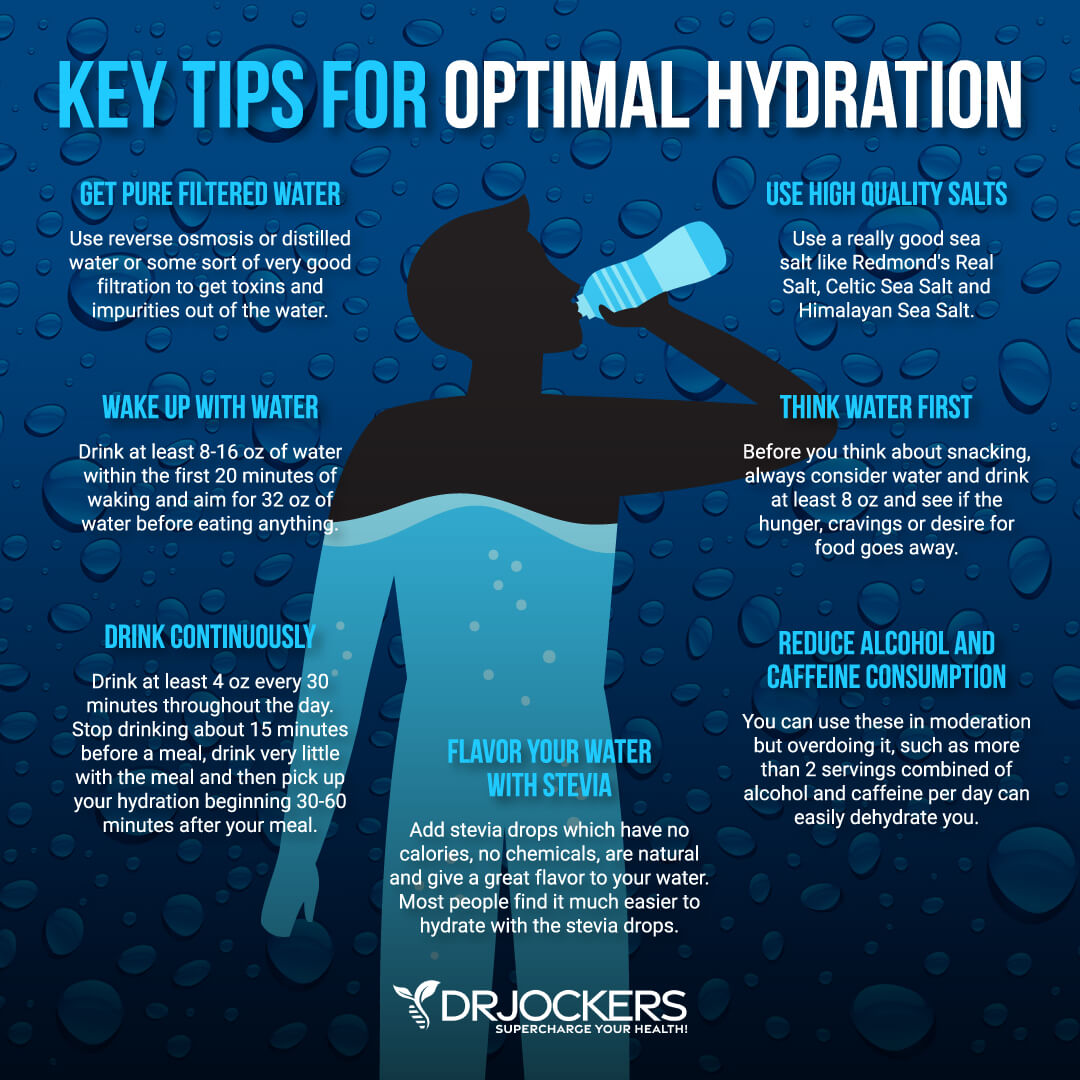
Step 2 – Remove Digestive Challenges
To repair your health and overcome rosacea, it is important that you don’t overburden your system and remove any toxins, irritants, and infections that may be causing your issues. The next step is removing your digestive challenges.
Avoid Food Sensitivities
Food sensitivities may be one of the major triggers and causes of your rosacea. Once you have identified your food sensitivities, it is important to remove them from your diet.
If you are not sure about your food sensitivities, you may start with the most common culprits, such as gluten, sugar, alcohol, coffee, tea, spicy foods, histamine-increasing foods, and cinnamaldehyde-containing foods. Also remove any processed and junk foods from your diet that may include inflammatory, artificial, toxic, or otherwise triggering ingredients.
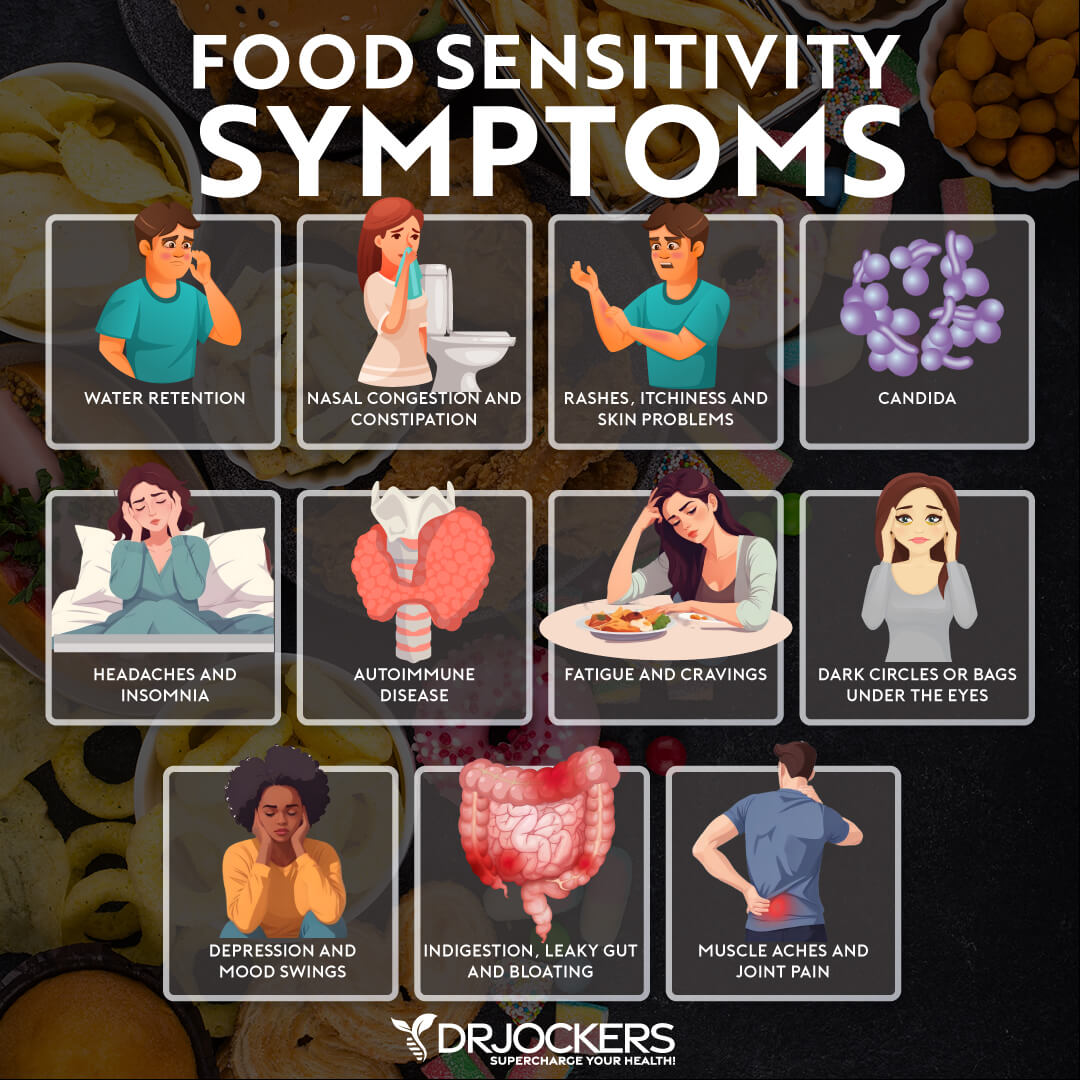
Eliminate Gut Infections
While changing your diet to an anti-inflammatory diet abundant in nutrient-dense foods, it may not be enough. You may benefit from supplements to eliminate your gut infections and to support your gut health. I recommend GI Clear to clear up your gut infections.
It is made with powerful herbs, such as Tribulus extract, berberine root, black walnut powder, barberry extract, and artemisinin from sweet wormwood, as well as magnesium caprylate to handle any bacterial, yeast, or parasitic overgrowth and support a healthy gastrointestinal microbial balance. Take one capsule a day, or two capsules for an advanced dose.
Improve Digestive Health
When you are dealing with an underlying gut health issue, it is important to support your body with enzymes and hydrochloric acid (HLC) to improve your digestive health.
Super DZyme supports the healthy digestion of macronutrients, enhances nutrient absorption, supports the breakdown of polysaccharides, supports pancreatic and brush border enzyme function, and helps the breakdown of lactose.
Stomach acid is crucial for creating an acidic environment in the stomach to digest protein and ionize minerals. Acid Prozyme supports healthy stomach acid production, reduces microbial overgrowth, improves protein and amino acid digestion, helps nutrient absorption, and reduces digestion discomfort.
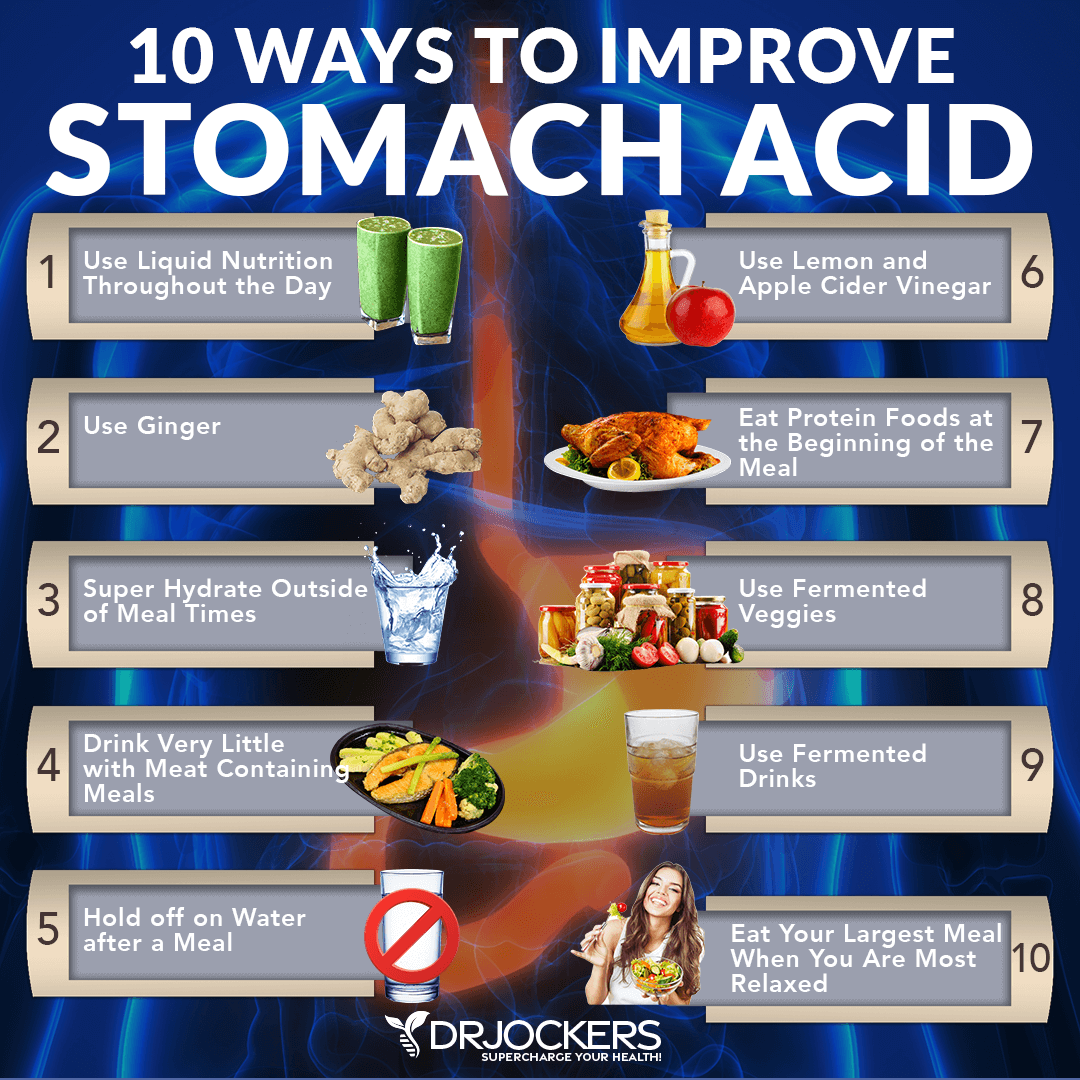
Support Liver Health
A compromised liver can compromise the health of your entire body. Supporting your liver health is essential to support detoxification, healthy digestion, reducing inflammation, eliminating the risk of disease, and supporting your overall health.
I recommend reading this article on the best foods and strategies to support your liver health and improve your body’s drainage pathways.
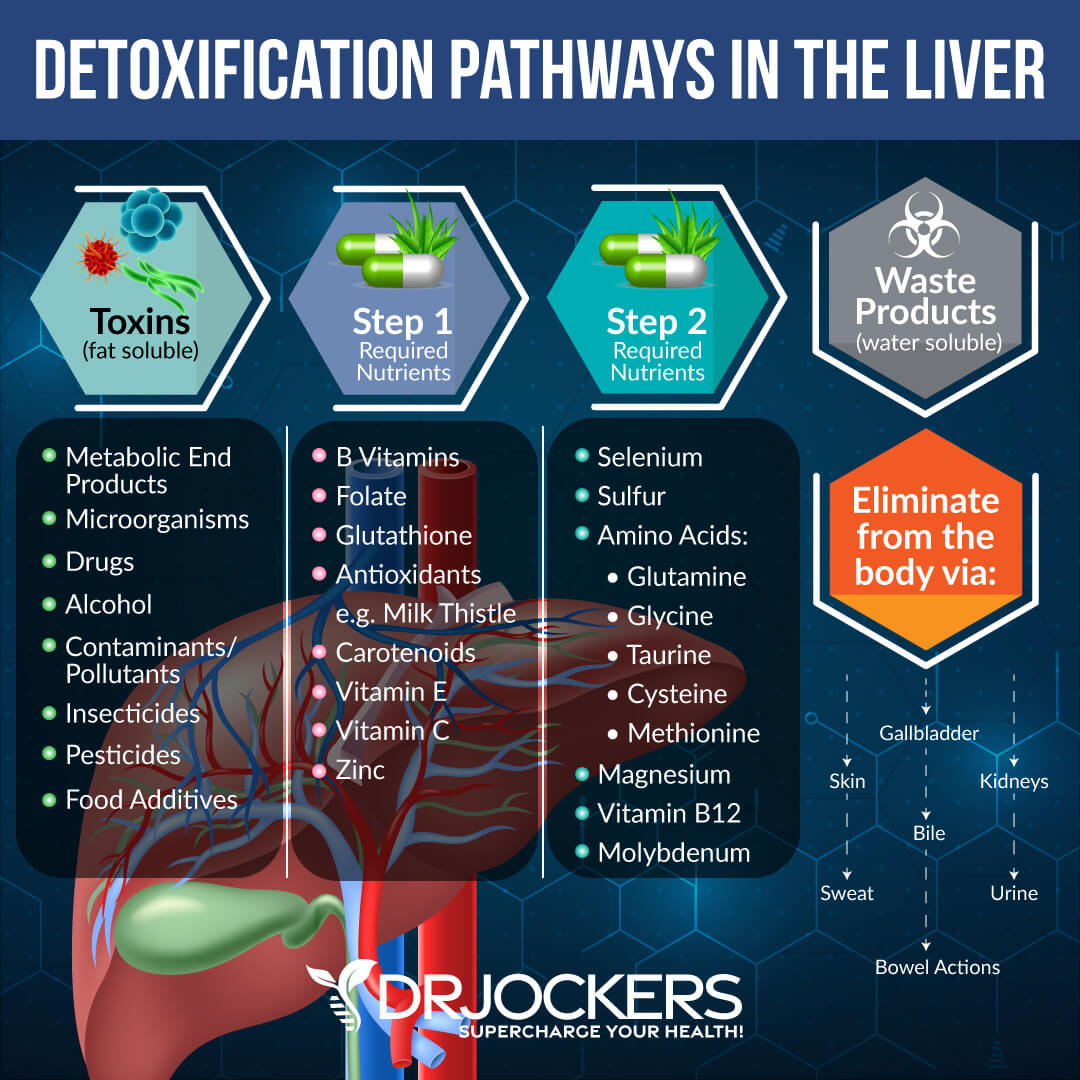
Step 3 – Rebuild the Microbiome
Once you have removed digestive challenges, such as food sensitivities, bacterial overgrowth, infections, and sluggish digestion, you must rebuild your microbiome. Your microbiome is the foundation of your overall health. A healthy microbiome may reduce the risk of inflammation and disease, including rosacea flare-ups.
Improve Gastric Mucosa
To rebuild a healthy microbiome, it is important that you improve your gastric mucosa. The mucosa is where the immune component of your gut lives and it is important to produce secretory IgA which protects your gut lining from bad bacteria, yeast, parasites, and toxic debris.
Read this article on strategies to support the gut mucosa and the best supplement for this is the Mega Mucosa which we use as we are cleaning up the microbiome.

Use Probiotics
Taking high-quality probiotics is crucial for rebuilding a healthy microbiome and ensuring a healthy gut flora balance. When it comes to probiotics, there are 4 main categories: 1) Food based – lactobacillus and bifido bacterium, 2) Sacchromyces Boulardii – the beneficial yeast organism, 3) Soil Based spore forming bacteria and 4) Combination forms. This article goes over when to use each specific form.
A great probiotic that I often recommend is SBO Probiotics – Ultimate which has a combination of soil-based spore forming probiotics and Sacchromyces Boulardii to help support a healthy digestion, nutrient absorption, immune system, skin, joints, brain, energy levels, and overall health. It’s made with organic ginger, turmeric and black pepper which help improve digestive health and reduce gut inflammation.

Final Thoughts on Rosacea
Rosacea is a common inflammatory skin condition characterized by facial redness, and visible blood vessels. It can be an uncomfortable and sometimes embarrassing skin condition. However, once you identify the root causes of your rosacea, you may be able to get noticeable improvement. Follow my 3-step support strategy process to repair your gut and improve your skin health.
If you want to work with a functional health coach, I recommend this article with tips on how to find a great coach. On our website, we offer long-distance functional health coaching programs. For further support with your health goals, just reach out—our fantastic coaches are here to support your journey.
Inflammation Crushing Ebundle
The Inflammation Crushing Ebundle is designed to help you improve your brain, liver, immune system and discover the healing strategies, foods and recipes to burn fat, reduce inflammation and Thrive in Life!
As a doctor of natural medicine, I have spent the past 20 years studying the best healing strategies and worked with hundreds of coaching clients, helping them overcome chronic health conditions and optimize their overall health.
In our Inflammation Crushing Ebundle, I have put together my very best strategies to reduce inflammation and optimize your healing potential. Take a look at what you will get inside these valuable guides below!


